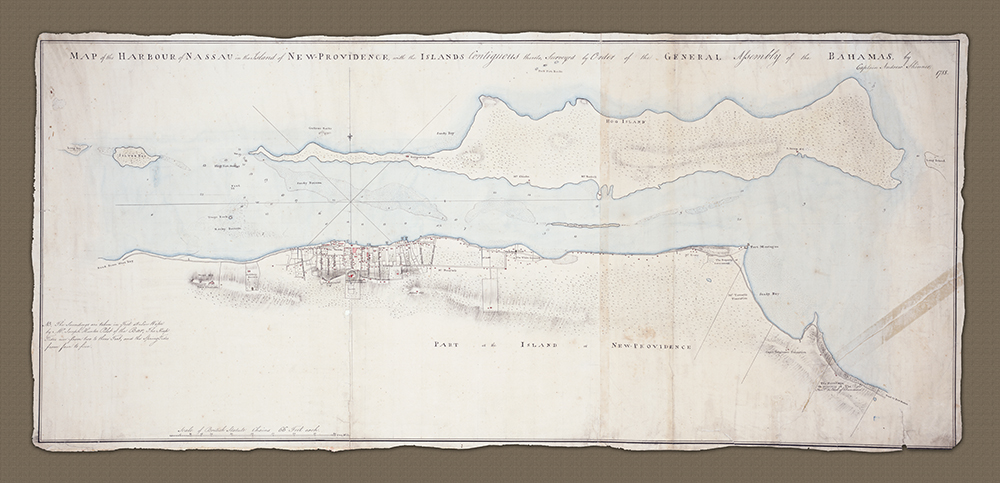Nassau had, in the twenty or so years prior to this map, a colorful history which had seen it invaded, destroyed and rebuilt by Spanish, Dutch, Americans and of course the British.
In 1776 it was invaded by the Americans and in 1778 the British forced them out. As late as 1782 the Spanish invaded and were famously, the following year, forced-out again by an American loyalist called Andrew Deveaux without so much as a shot being fired. The map was drawn, by Andrew Skinner, who simultaneously produced a major census of the town which lists all proprietors of lots and residences in the town, now held by the Bahamian National Archives. Deveaux is not, by the way, listed amongst the residents in 1788.
By 1788 Nassau had seen a major immigration of thousands of American loyalists and previously enslaved Africans to the Bahamas following the Revolutionary War. With the bulging population came increased trade and growth to the settlement.
This map clearly shows that the island was still however, in 1788, largely undeveloped with the surrounding country and what today we know as Paradise Island - then 'Hog Island' - was simple bush land.
The first of the Plantations on New Providence had started to emerge belonging to Mr Tattnall and Captain Hamilton. The Earl (Lord) of Dunmore's private country residence called 'The Hermitage' is also marked, along with the official residence in the center of the town at Mount Fitzwilliam. Dunmore was appointed the colony's Governor in 1780 and he oversaw the development of Fort Charlotte which is marked out to the west of the town.
Amongst the points of interest the map offers is an isolated 'Banqueting House' on the western end of Hog Island, 'Gallows Rocks' just off the North West coast of the Island - a not-uncommon feature of Islands and coastal towns of the day which wished to discourage piracy and 'wrecking'. The town's artillery barracks are shown between the town and Fort Charlotte. Individual houses and Lots are mark to correspond with the census and streets are named. Finally, hydrographical information in the form of depths, sand-banks and rocks complete the survey.
Captain (of the Guides regiment) Andrew Skinner, a celebrated surveyor back in Scotland prior to 1776 had worked along with George Taylor, his long-time collaborator, on various surveys around New York for General George Clinton around 1781 and 1782.
This delightful manuscript plan of the town of Nassau, capital town of the Bahamas was drawn at a time when the Bahamas had just started to establish itself as the principle commercial and political center of the Island group with strong links to mainland America. Nassau had in the twenty or so years prior to this map had a colorful history which had seen it invaded, destroyed and rebuilt by Spanish, Dutch, Americans and of course the British.


